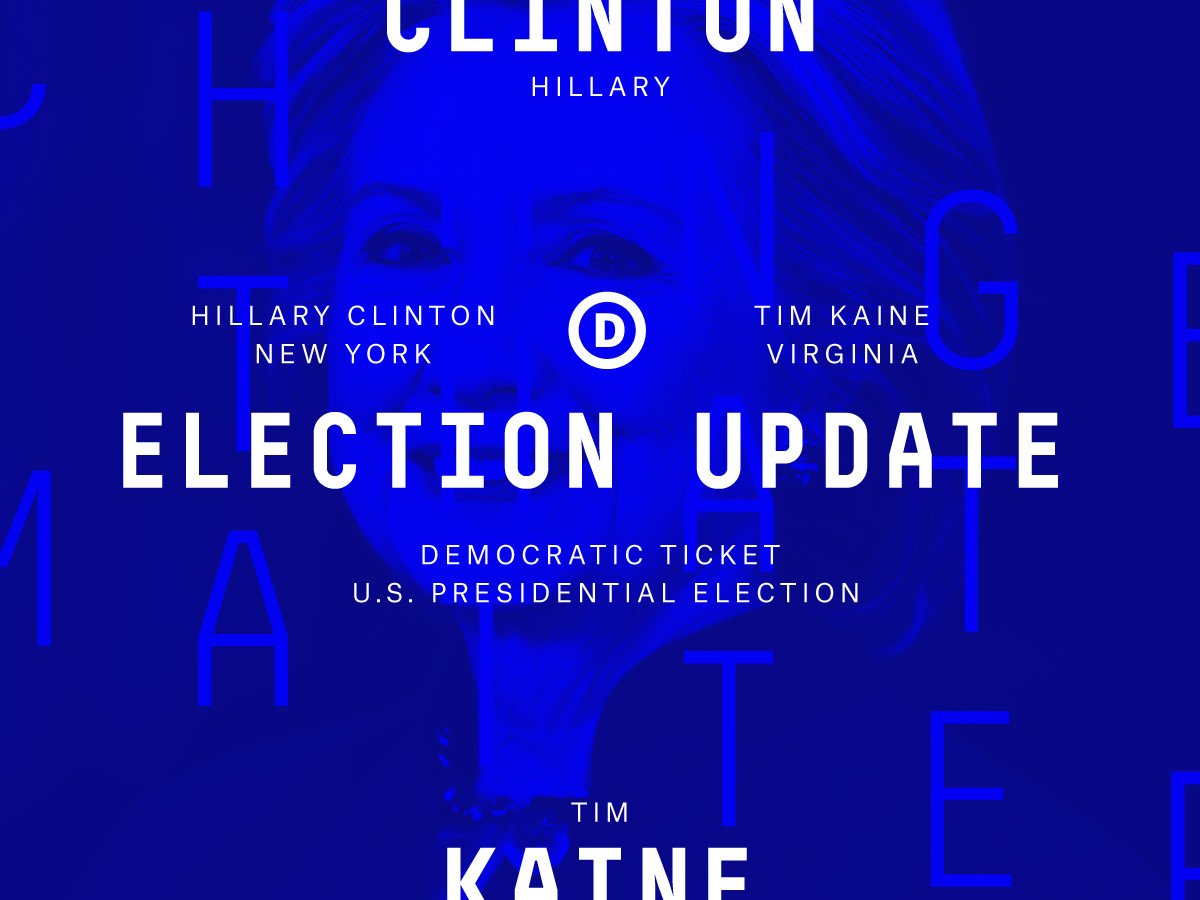
Last week, Politico reported that Hillary Clinton’s campaign was set to employ a “run out the clock” strategy, declining to respond to recurring controversies even at the risk of seeming nonresponsive. In the abstract, such a strategy could make sense. Clinton has a fairly clear lead in the polls. There are only 10 weeks to go until the Nov. 8 election — and less than that until early voting, which begins in late September in some states.
But Clinton shouldn’t get too complacent. After mixed evidence before, it’s become clearer, at least according to our forecast models, that Donald Trump has regained some ground on her. Clinton’s national lead in ourpolls-only forecast has gone from a peak of about 8.5 percentage points two weeks ago to 6.5 percentage points as of Sunday evening — that is, a 2-point gain for Trump over two weeks. Correspondingly, Trump’s chances of winning the election have improved from a low of 11 percent to 19 percent.
Trump’s gains have been more modest in our polls-plus forecast, which discounted Clinton’s early August polls because of a potential convention bounce and which anticipated that the race would tighten. In polls-plus, which forecasts that Clinton’s margin over Trump will narrow to roughly 4 percentage points by Election Day, the clock is more of an ally to Clinton and an enemy to Trump. Still, Trump is keeping slightly ahead of the pace of improvement that polls-plus expected of him. His chances of winning are 27 percent according to polls-plus, up slightly from 25 percent a week ago and from a low of 21 percent earlier this month.
None of this is to say that there’s been some game-changing shift toward Trump. There probably hasn’t been, and you wouldn’t necessarily anticipate one given that, after such an action-packed period earlier this summer, there have been a lot of slow news days amid the August doldrums. Generally speaking, polls don’t move suddenly without a good reason.
But the polls can move gradually, whether because they’re reverting to a previous mean (a convention bounce wears off) or because of the cumulative effects of the campaign (an undecided voter finally makes up her mind). Lately, that movement seems to be slightly toward Trump.
The clearest case for this is in a set of daily and weekly tracking polls, several of which — including the Morning Consult poll, the UPI/CVoter poll, theGravis Marketing poll, and the Ipsos/Reuters national tracking poll — show Clinton at or near her post-convention lows (and in some cases, within the margin of error of Trump overall). There are also a couple of exceptions: The Republican-leaning Rasmussen Reports poll showed Clinton gaining ground this week, and the Ipsos/Reuters 50-state tracking poll, which has a considerably larger sample size than Ipsos’s national tracking poll, showed Clinton steady to slightly improving from the previous week.
But a candidate doesn’t need to gain ground in every poll to gain ground in our forecast, just in the preponderance of them. If the race shifts by 7 points toward a candidate essentially overnight, as it did toward Clinton following the Democratic convention, it’s going to be obvious in almost every poll. But such moves are rare, and a gradual shift — like Trump gaining 2 points over two weeks — will manifest itself in fits and starts in the averages.
A concern for Trump is that these gains haven’t been as apparent outside of those national tracking polls, all of which are conducted online or by automated script and several of which have a Trump-leaning house effect. The most recent traditional telephone poll, from Quinnipiac University, had Trump down by 7 percentage points — or down 10 points without third-party candidates — a poor result for him given that Quinnipiac had beenone of the better traditional pollsters for Trump earlier in the cycle. There haven’t been very many of those traditional polls lately; it’s been a few weeks since we got numbers from any of the five major national surveys that will be used to determine eligibility for the debates, for example.
Polls in swing states were all over the place last week, meanwhile. In Florida, for example, we saw surveys showing everything from a 14-point lead for Clinton to a 3-point lead for Trump. If you squint, you can perhaps perceive some movement back toward Trump in some of the red-tinged swing states, such as North Carolina. But it’s hard to say for sure. A lot of the swing state polls released last week were from pollsters surveying the states for the first time, meaning that they didn’t have trend lines, or if they did have trend lines, they didn’t show much change from the previous version of the survey. The pollster that had Clinton up by 14 points in Florida, for example, had her ahead by 13 points when it previously surveyed the state in June.
Contents
How the clock does and doesn’t help Clinton
It’s nice to have a model at times like these, instead of just throwing up your hands (or worse, cherry-picking polls to suit your case). And that model, as I said, shows Trump as having gained about 2 points over two weeks. If Trump keeps gaining 1 percentage point a week, he’ll beat Clinton by a couple of percentage points on Nov. 8. Hence, Clinton should probably not be picking out the White House drapes just yet.
Continued gains may not be so easy for Trump, however. He’s still at only 37 or 38 percent in national polls that include third-party candidates. That might seem like an easy number to improve upon, but his favorability rating is only about 35 percent, meaning that he’s already relying on support from a few voters who don’t like him but may vote for him to prevent a Clinton presidency.
Clinton also has some work to do. She’s at about 43 percent in national polls and in polls of key swing states — not enough to clinch victory, even if 6 to 10 percent of the vote eventually goes to third-party candidates, as appears increasingly likely. She’ll need to persuade a few undecided voters toward her side or get some of those third-party voters — more of whom have Clinton than Trump as their second choice — to turn out for her.
Our models rely on both the number of days until the election and on the number of undecided and third-party voters to calculate the uncertainty in the race. Because the conventions were held early this year, it can be easy to forget that it’s still just August. (On this date four years ago — Aug. 28, 2012 — Republicans were holding their convention in Tampa and the Democratic convention hadn’t even started yet.) Meanwhile, there hasn’t been much of a decline in the undecided or third-party vote. As compared with July 17, the date before this year’s Republican convention, Clinton has gained only 2 to 3 percentage points in the polls and Trump hasn’t gained at all.
Toward the end of the 2012 campaign, we frequently emphasized the distinction between closeness and uncertainty. President Obama led Mitt Romney by just 1 or 2 percentage points nationally, according to our models, throughout much of the stretch run of that campaign — a close race. But between Obama’s consistently strong numbers in the swing states, the low number of undecided voters, and a strong alignment between polls and economic “fundamentals,” there was a narrow range of plausible outcomes for that election, with most of them resulting in a second Obama term.
The Elections Podcast Checks In On The 2016 Forecasts
This election, at least for the time being, presents something of the opposite case. It isn’t all that close — Clinton is up by around 6 percentage points as best as we can figure, a larger lead than Obama had at almost any point in 2012 or until the very end of the 2008 campaign. But it’s August, and the number of undecided voters is high, and so the outcome remains fairly uncertain. Furthermore, while the state polls are fairly good for Clinton right now, we don’t know how they’ll react if the race tightens further. We’re going on three weeks without a live-caller poll in Pennsylvania, for example.
Coincidentally or not, the Clinton campaign was more proactive last week. Itpushed back quite aggressively at an Associated Press story about donations to the Clinton Foundation. And it instigated a fight with Trump over his connections with what Clinton called “the emerging racist ideology known as the alt-right.” Clinton remains in a strong overall position, but she shouldn’t be playing prevent defense yet; we’re still in the equivalent of the third quarter.
[Source:- UPI]



